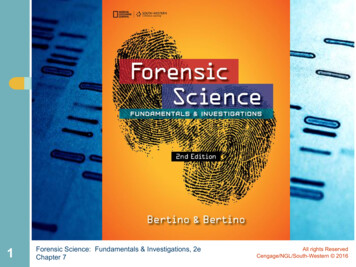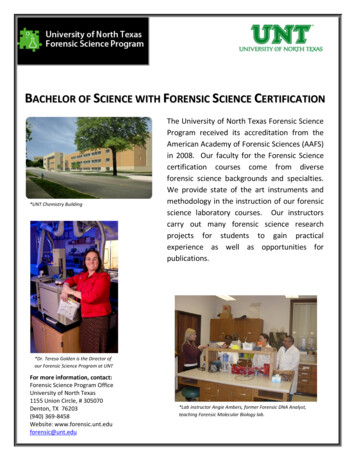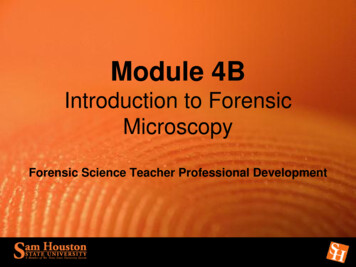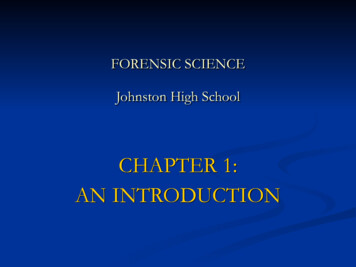
Transcription
1Forensic Science: Fundamentals & Investigations, 2eChapter 7All rights ReservedCengage/NGL/South-Western 2016
Tuesday December 15, 2015Teaching Points: Students will be able to 1 Explain how DNA can be important tocriminal investigations.2 Explain how crime-scene evidence iscollected for DNA analysis.3 Describe how crime-scene evidence isprocessed to obtain DNA.4 Explain what a short tandem repeat (STR) is,and explain its importance to DNA profiling.2Forensic Science: Fundamentals & Investigations, 2eChapter 7All rights ReservedCengage/NGL/South-Western 2016
Chapter 7 DNA ProfilingIntroductionoMid-1980s oEarly 1990s oThe US military began collecting and storingblood samples of soldiers1994 3DNA fingerprinting dramatically changed forensicscience and the ability of law enforcement to linkperpetrators with crime scenes.DNA Identification actForensic Science: Fundamentals & Investigations, 2eChapter 7All rights ReservedCengage/NGL/South-Western 2016
Introduction (continued)o1998 oCODIS (The Combined DNA Index System) oNational DNA Index System (NDIS)Collects, analyzes, and communicates criminal DNAinformationBy 2014, CODIS had: 11.1 million offenders its DNA profiles1.9 million arrestee DNA profileso4More than 257,000 hits assisting in more than 246,000 investigationsForensic Science: Fundamentals & Investigations, 2eChapter 7All rights ReservedCengage/NGL/South-Western 2016
What is DNA?oDNA deoxyribonucleicacid o5The genetic material of allliving thingsWith the exception of redblood cells, all human cellscontain DNA.All the DNA found inhuman cells makes up thehuman genome.Forensic Science: Fundamentals & Investigations, 2eChapter 7All rights ReservedCengage/NGL/South-Western 2016
6Forensic Science: Fundamentals & Investigations, 2eChapter 7All rights ReservedCengage/NGL/South-Western 2016
Chromosomesoooo7The 46 chromosomes found in human bodycells are composed of tightly coiled DNA.Most males have one X and one Y sexchromosomes (XY).Most females have two X chromosomes(XX).Half of your DNA is inherited from yourmother and the other half is inherited fromyour father.Forensic Science: Fundamentals & Investigations, 2eChapter 7All rights ReservedCengage/NGL/South-Western 2016
8Forensic Science: Fundamentals & Investigations, 2eChapter 7All rights ReservedCengage/NGL/South-Western 2016
Genesoo9A gene is a segment of DNA in achromosome that serves in theproduction or regulation of proteins.Genes average about 3000 base pairs,but they can be composed of manythousands of base pairs.Forensic Science: Fundamentals & Investigations, 2eChapter 7All rights ReservedCengage/NGL/South-Western 2016
10Forensic Science: Fundamentals & Investigations, 2eChapter 7All rights ReservedCengage/NGL/South-Western 2016
Collection and Preservationof DNA Evidenceooo11Using polymerase chain reactions (PCR),trace samples of DNA evidence can beamplified so that adequate amounts of DNAevidence are available for testing.Avoiding contamination when collecting,preserving, and identifying DNA evidence iscritical.DNA evidence should be kept dry and coolduring transportation and storage.Forensic Science: Fundamentals & Investigations, 2eChapter 7All rights ReservedCengage/NGL/South-Western 2016
Forensic DNA and PersonalIdentificationooo12DNA profiling is the most useful tool for lawenforcement since the development offingerprinting.Scientists use polymorphisms to distinguishone person from another.Because 99% of all human DNA is the same,scientists only need to examine the1% regionof variability.Forensic Science: Fundamentals & Investigations, 2eChapter 7All rights ReservedCengage/NGL/South-Western 2016
Early DNA FingerprintingUsing Gel Electrophoresisooo13In DNA fingerprinting, DNA is isolated andcut using restriction enzymes, creatingfragments of DNA called restrictionfragments.Each person's length and number of DNArestriction fragments differs.Gel electrophoresis has been replaced by theuse of STR analysis, which analyzes shorterpieces of DNA.Forensic Science: Fundamentals & Investigations, 2eChapter 7All rights ReservedCengage/NGL/South-Western 2016
Short Tandem Repeats (STRs)ooo14The repeating bases in STRs are shorterthan the repeating bases used in DNAfingerprinting.STRs can be more easily recovered fromthe often degraded and limited quantitiesof DNA typically found in evidence.The FBI uses 13 core STRs foridentification of Americans.Forensic Science: Fundamentals & Investigations, 2eChapter 7All rights ReservedCengage/NGL/South-Western 2016
15Forensic Science: Fundamentals & Investigations, 2eChapter 7All rights ReservedCengage/NGL/South-Western 2016
Forensic Science: Fundamentals & Investigations, 2e Chapter 7 All rights Reserved Cengage/NGL/South-Western 2016 Tuesday December 15, 2015











